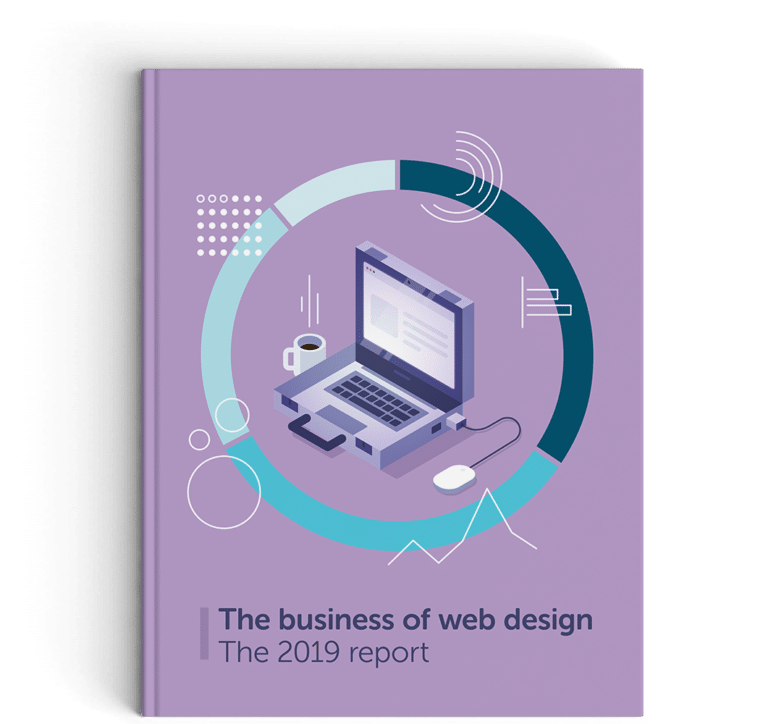
Most freelance creatives have one experience in common: that moment they realized how much of a creative business involves non-creative things. For me, it was after finishing the assignment for my first client and realizing how much “wrap-up work” was still left to do.
Being a freelance designer also means taking off your design hat now and then to be a bookkeeper, copywriter, sales person, and more. You’re running everything on your own and while sure, you can outsource and get help, you still need a solid understanding of it all.
You are the boss, after all.

And that stuff’s not where your heart is, and definitely not what you wanted to make a career out of. So it really sucks that the more successful and skilled you are, the more clients you get, the more admin you’re going to have to do – taking away time from other design projects you could be working on.
Unfortunately, spending at least a little time on admin and marketing and other parts of business is unavoidable. But there are definitely painkillers for the situation.
You can get smart and figure out ways to spend as little time on that stuff as possible so you can stay in your “design cave” more and more and just pop your head out for essential admin tasks.
As a side-hustle freelancer, I have no choice but to work incredibly smart. I’m sure you can relate. When you only have 10 or so hours per week to grow your business, spending even one full hour in your invoicing software can feel like a waste, like you’re being held back from outstanding work that’ll make people notice you.
So here are the best ways to work smart and streamline the boring stuff.
The four types of streamlining to take notice of
Between all the life hacks and life-changing apps and everything in between, it’s easy to get overwhelmed by all the productivity advice out there. Some tools and teachers make sweet promises that feel pretty tempting.
But a lot of people overcomplicate it. Especially when you’re first mastering this whole streamlining thing, it’s best to keep things simple.

Here are what I like to call the four categories of working smart:
1. Outsource to someone else
Outsourcing part of your work to someone else is a pretty obvious way to get rid of things you don’t like on your to-do list. It’s the most drastic tactic (cutting a task completely instead of just saving time on it), so you’ll save a lot of time, but it’s also one of the more expensive methods.
A good way to get started is to hire a general virtual assistant to handle a few things holding you back. I like the way Indigo Colton defines it on The Freelance to Freedom Project: “They are taking over tasks that your business needs done to run smoothly, but either you hate doing or that take up way too much of your time.”
2. Automate using an app
This is my personal favorite method of saving time. Technology is so smart now, it’s crazy. Let it do all that it can for us. Workflow automation can help you skip entire steps or stages of your freelance admin. It’s also particularly great for the kind of admin stuff we’re going to talk about in this post since it’s mostly low energy, easy tasks.
Searching for a great invoicing app? Look no further.
3. Batch work
Take any admin or non-creative tasks that have a few things in common or are done in the same tool, group them together, and start treating them as a single task or process. As The Muse explains, it works because “This method supposedly increases your productivity by helping you avoid that frantic switching of gears that always occurs when you hop from project to project.”
That could mean a dedicated day for meetings (or no meetings). Maybe it’s a set hour each day where you send all emails, invoices, and other outgoing communication instead of doing it as the subject pops up. Any small or short tasks that pop up frequently on your to-do list, you could streamline by batching into a few larger sessions.

4. Creating templates
Templates can be used in almost any area of your freelance design business. I’m sure you have templated parts of your design process, a basic contract and invoice template, and other staples. But there are tons of other uses, like for social media posts, emails, even client consult calls. You may not always be able to use completely canned responses, but creating “fill-in-the-blank” templates or prompts for yourself also saves a lot of time.
Now, let’s dive into the specifics.
Spend less time on email
Email is one of the most necessary evils for any professional. There’s no way to avoid talking to clients, so you’ve got to focus on figuring out ways to use less email and get through your inbox faster.
Use auto-responses
First off, set up auto-responses for common types of emails you get like new client inquiries, FAQs, and contact form submissions. If you’re telling different people the same thing over and over again, you should use an auto-response for it.

Even if you still need to hop in and answer part of someone’s question or provide more information, this automatic email gives people more information and buys you time to respond! For example, you could hook up an auto-response to your client intake form that includes information and links about what’s next.
You would still need to go look at your new prospect, but wouldn’t need to rush to reply to them right away since this went out automatically.
Most contact forms will have an auto-response feature built-in, and tools like a CRM or Zapier can help you set them up for the rest of your inbox.
Create canned response templates
For any response that’s repetitive but requires too much customization to automate your reply, skip a few steps by creating an email template you can edit and send off.
Think of emails like explaining your availability or pricing to a potential client – it depends on the timing and situation, but only one part of that email (the actual date or price) needs to be customized to each person.
This means they’re perfect for email templates! These can be created in your CRM (which we’ll talk about later), a built-in tool like Gmail Canned Responses, or simply copying and pasting templates from a word document into a new email.

Auto-filter your inbox
I’m talking way more than the few inbox tabs, like “Promotion,” that Gmail automatically gives you. You can actually turn those off and create more advanced rules to automatically move things to different tags and folders, mark emails as read, and more based on their senders, subject lines, or words used in the email. Other email providers have similar features as well.
When you do need to step away from client work to check email, you want to focus on important emails. Answer any clients, prospects, partners, etc. and get back to design before getting distracted by newsletters, discount promotion, and people cold pitching you.
Send automatic updates
One task that always used to slip my mind was sending weekly or milestone updates to a client. If I had a client I was supposed to send Tuesday updates to, it would come in at 12:01 am Wednesday more than once. Communicating around updates is important, but it can also feel tedious, especially with clients that request them all the time.
The best way to take care of this is through good project management and collaboration tools. They’ll have features like email notifications and digests that will automatically let your clients know as you’re checking off items, moving products along your pipeline, and other “getting work done” items. And you won’t have to send an email after every item crossed off your to-do list.
Use an appointment scheduler
Don’t you hate all the back-and-forth required in setting up an appointment? It’s never as simple as, “Are you free at this time?” “Yes!” “Great!” You’re emailing with your client and comparing schedules trying to find a time that works for both of you.
Instead, a streamlined appointment booking tool like Acuity or Calendly lays out your availability to clients and lets them reserve a spot on your calendar from there. So simple.

Find and land new clients in less time
Marketing yourself and working any new leads is another necessary evil. You can’t get new clients without marketing, or at least by branding yourself well enough that your business markets itself. And when that starts working, it takes more wheel turning to take someone from interested in your services to paying for them. Here are the parts of it you can streamline.
Create an email marketing sequence
You should already be using email marketing for your freelance business. If you do, you probably send a weekly or monthly email newsletter and might have a free opt-in offer on your website.
You can take that even further to turn any subscriber who hasn’t yet filled out your “hire me” form into an informed and interested lead. Use a welcome sequence to nurture them, let them know about how you can help them, and ultimately pitch your “hire me” form again.
Use smart contact forms
For people who are ready to go straight to the “hire me” form on your website, you want that to be the first step in a seamless client onboarding process. That means you need to have detailed enough contact forms that you’ll have all the information you need to move them to the next step in your client intake process to minimize any back and forth and save on stress. And that may mean more than one contact form on your site.
But when your forms are detailed, you can easily tie them to next steps. For example, a detailed form can lead into a customized email sequence or autoresponse email.
Automate or batch social media promotion
Jumping onto Facebook or Twitter to market yourself can easily be a time suck. First there’s the time each day or week that the actual marketing work takes. But then there’s the extra time you spend on the network after you finish that, after you’ve been distracted and start scrolling through your feed.
By automating social media publishing with a tool like MeetEdgar or scheduling it all at once at the beginning of each week, you can go back to work and still put your name out there.
Use a CRM for contracts and onboarding
Your design process probably includes a lot of forms, contracts, and other documents. For example, there’s the initial contract, any invoices, forms for signing off on approvals, and all that jazz.

A CRM makes it easy to keep track of everything going on. One tool pretty popular with freelance designers lately is Dubsado, which focuses its product on helping creative freelancers and small business owners.
Create drip campaigns
When you’re using a CRM – either Dubsado or another tool – they make it pretty easy to send a series of emails to clients. These are different from email marketing sequences in that they’re automatically sending over client documents, updates, etc. so admin is happening behind the scenes without you stepping away from Adobe.
Get paid
Remember that a-ha moment I told you about? I had just finished writing and editing my first freelance blog post and realized there was a lot more work to do before I actually saw my money. And worse, I couldn’t go after my next client until I did it. My, I’ve come a long way, and here’s how you can streamline, too.
Send automatic and recurring invoices
If you’re sending more than one invoice to someone, you should do whatever possible to knock out all the work at once. Most invoicing software makes this easy for you.
You can either set a payment schedule up front and have automatic invoices go out accordingly, set recurring invoices up for an ongoing client, or connect your invoicing tool to your project management tool so they can sync with each other.

Automate payment reminders
It would be great if every client was eager and on time to pay you, but that’s not the life of most freelancers. Instead, we have to stay on top of them, send them reminders of upcoming due dates, and in the worse cases, chase after late payments.
Or do we? It may not be an obvious feature in every CRM and invoicing tool, but most of them do let you set automatic emails and reminders triggered by payment deadlines you’ve set up.
Track income and expenses
Once you do get paid, it’s time to celebrate, not jump straight into your bookkeeping software. Logging income and expenses isn’t something you should be spending time on.
Between connecting software to your bank and payment cards, and being able to automatically log activities in customized spreadsheets through IFTTT or Zapier, you should be able to log in periodically and just review your finances, not organize them, too.
By making all these simple cuts here and there, you don’t have to worry about more important admin tasks that you can’t cut out. Five minutes here and five minutes there easily adds up to hours and hours more of designing you can do each week.

Download the free report!
In our 2019 report, we found some amazing insights after surveying over 1,000 creatives (mostly freelancers!) just like you. Learn what they are charging for, what services they’re selling, and so much more.






Comments ( 1 )
Andrew T McClellan
April 6, 2017
Great points all-around! For anyone who is just getting their business off the ground, I strongly recommend tracking your time in detail to see where your valuable time is actually being spent. We often tell ourselves "stories" throughout the day to make it feel as though we've been productive. Tracking your time will either confirm or reject those assumptions you're making, and achieve one of the most important responsibilities of any business owner: holding yourself accountable!